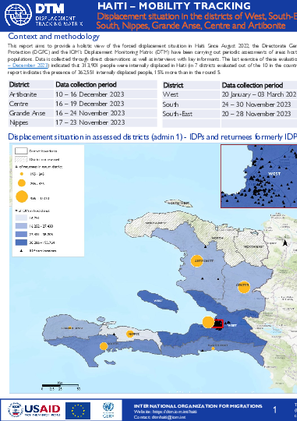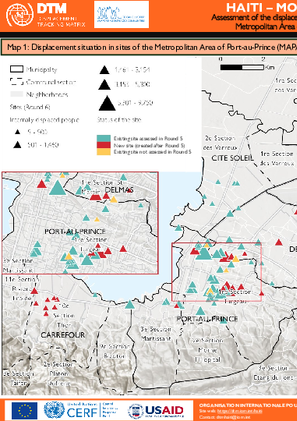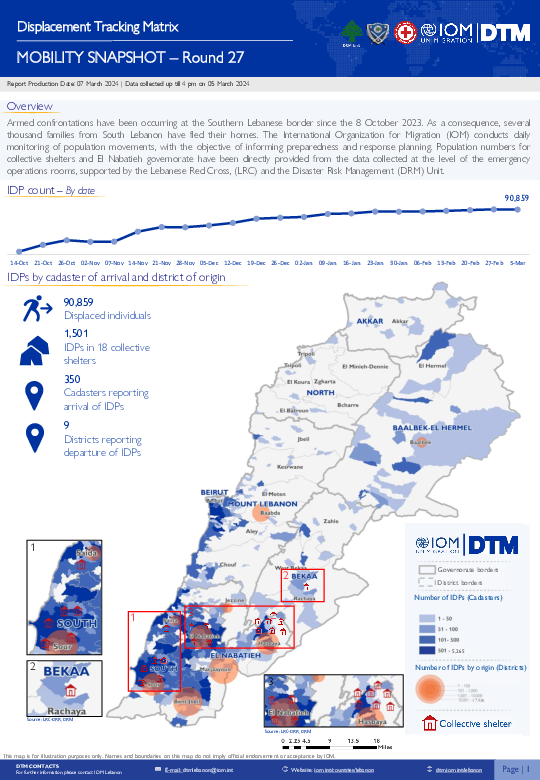-
Countries
-
Data and Analysis
-
Special Focus
-
Crisis Responses
Assessment Report

Contact
DTM Sudan; dtmsudan@iom.int
Language
English
Location
Sudan
Period Covered
Feb 29 2024
Mar 07 2024
Activity
- Mobility Tracking
- Baseline Assessment
Overview
On 15 April 2023, armed clashes erupted between the Sudanese Armed Forces (SAF) and the Rapid Support Forces (RSF) in multiple cities across Sudan. Clashes initially took place in cities across Northern and Khartoum states, later spreading across the Darfur and Kordofan regions.
Highlights
- DTM Sudan estimates that 6,467,700 individuals (1,289,341 households) were recently internally displaced.
- The IDP caseload was observed in 6,968 locations across all of Sudan’s 18 states.
- The highest proportions of IDPs were observed across South Darfur (12%), River Nile (11%), and East Darfur (10%).
- Field teams reported that the IDPs observed were originally displaced from twelve states. The majority (3,564,234 IDPs, 55%) were reportedly displaced from Khartoum state; followed by South Darfur (15%), North Darfur (9%), Aj Jazirah (8%), Central Darfur (5%), West Darfur (4%), South Kordofan (2%), East Darfur (1%), West Kordofan (1%), North Kordofan (1%), Sennar (<1%) and White Nile (<1%).
- IOM-DTM also reported that an estimated 1,918,309 mixed cross-border movements were made into neighbouring countries.
- This product provides brief insights into those displaced in Sudan post-15 April 2023. For more granular information on the IDP caseload and the displacement context, please see IOM-DTM's Monthly Displacement Overview 06.

Contact
DTM Haiti, dtmhaiti@iom.int
Language
English
Location
Haiti
Period Covered
Mar 08 2024
Mar 10 2024
Activity
- Survey
- Flow Monitoring Survey
- Flow Monitoring
Since 29 February 2024, several neighborhoods in the Metropolitan Area of Port-au-Prince (MAPAP), the capital of Haiti, have been targeted by increased armed attacks. Nearly 15,000 people were displaced following these attacks (see ETT 39.1). In addition to creating displacement within the MAPAP, these attacks are pushing more and more people to leave the capital to find refuge in provinces, taking the risks of passing through routes controlled by gangs. In order to monitor these movements towards the provinces and inform appropriate response strategies, DTM has launched data collections at several of the most used bus stations in the capital (see page 4 for more details on the methodology). Since the start of this activity, on 8 March, until 10 March, this activity allowed to observe the movements of 7,672 people leaving the MAPAP (see pages 2 and 3 for more details on the profile of these people ). The majority of them (66%) took means of transport heading towards the Grand Sud departments (Grande’Anse, South, Nippes and South-East). It should be noted that this region already hosts more than 116,000 people who had in vast majority, fled the MAPAP in recent months (see the report on displacement in the Grand Sud).

Contact
DTM Europe, DTMMediterranean@iom.int
Language
English
Location
Hungary
Period Covered
Jan 01 2023
Dec 31 2023
Activity
- Survey
Key findings:
- Twenty per cent of respondents live with people with specific needs or serious health conditions.
- Priority needs* include healthcare services (26%) and medication (18%).
- Households living with people with specific needs* include infants aged 0-4 years old (14%), children aged 5-17 years old (32%), and elderly above 60 years old (54%).
- Specific needs* include chronic diseases or serious medical conditions (90%), visual impairment (14%), people living with injuries (10%) and pregnant or lactating women (9%).
- The need for additional information* on healthcare services is reported by 32 per cent of respondents, with 15 per cent citing the need for information on access to medication.
- Top barriers to accessing healthcare services* include language barrier (75%), service costs (39%), lack of documents (28%), long queues (28%), and discrimination (17%).
- 58 per cent are Temporary Protection (TP) holders among those experiencing obstacles to access to healthcare.
- Seventy per cent of respondents pay for healthcare services and/or medication.
- The need for mental health and psyhosocial support (MHPSS) is needed by 5 per cent of repondents. Fifteen per cent requires more information on MHPSS, and 5 per cent have received MHPSS in 2023.
(*more than one answer possible)

Contact
DTM Nigeria, iomnigeriadtm@iom.int
Language
English
Location
Nigeria
Period Covered
Dec 08 2023
Dec 30 2023
Activity
- Mobility Tracking
- Baseline Assessment
As of December 2023, DTM identified a total of 1,092,196 internally displaced persons (IDPs) in 183,437 households across Benue, Kaduna, Kano, Katsina, Nasarawa, Plateau, Sokoto, and Zamfara states. The data collection started in December 2023 in 1,646 locations, in the eight states of north-central and north-west Nigeria. The IDP population included IDPs in camps and camp-like settings (196,502 individuals or 18%) and IDPs residing in host communities (895,694 individuals or 82%). This signifies an IDP increase of 1.5 per cent or 16,303 IDPs compared to what it was in September 2023.

Contact
IOMDTMPoland@iom.int
Language
English
Location
Poland
Period Covered
Jan 01 2023
Dec 31 2023
Activity
- Survey
Key Findings:
- Among respondents, 46 per cent spent more than one year in displacement. 20 per cent of respondents had spent less than a month in displacement at the time of the interview.
- The majority of respondents (57%) were travelling back to Ukraine alone. The remaining 43 per cent of survey respondents were crossing back into Ukraine as part of a group. 95 per cent of respondents travelling with a group (N=1,998) were travelling with their immediate family
- Out of 4,650 respondents, 86 per cent were planning to return to the same oblast of origin while the remaining 14 per cent aimed to reach a different one. Out of those returning to a different oblast (N=667), 16 per cent were originally from Donetska oblast, 14 per cent from Dnipropetrovska, 13 per cent from Zaporizka, and 12 per cent from Kyiv city.
- The percentage of respondents that had been residing in Poland prior to crossing back to Ukraine decreased steadily from 59 per cent in the first quarter of 2023 to 46 per cent in the fourth quarter (overall 50%).
- Overall, the top four most frequently indicated reasons for returning to Ukraine for the long-term were missing home (52%), reuniting with family (20%), working in essential services (16%), and because they had been visiting someone abroad but reside in Ukraine (15%).
- The proportion of respondents that reported having experienced discrimination has steadily risen from seven per cent in the first quarter to 18 per cent in the fourth quarter.
- Of respondents who received humanitarian assistance, the most frequently reported type was financial support (86%), for which the percentage has increased throughout the quarters of 2023.

Contact
DTM Haiti, dtmhaiti@iom.int
Language
English
Location
Haiti
Period Covered
Nov 16 2023
Mar 03 2024
Activity
- Mobility Tracking
- Site Assessment
- Baseline Assessment
- Village Assessment
This report aims to provide a holistic view of the forced displacement situation in Haiti. Since August 2022, the Directorate General of Civil Protection (DGPC) and the IOM’s Displacement Monitoring Matrix (DTM) have been carrying out periodic assessments of areas hosting displaced populations. Data is collected through direct observations as well as interviews with key informants. The last exercise of these evaluations (Round 5 – December 2023) indicated that 313,901 people were internally displaced in Haiti (in 7 districts evaluated out of the 10 in the country). This new report indicates the presence of 362,551 internally displaced people, 15% more than in the round 5

Contact
DTM Haiti, dtmhaiti@iom.int
Language
English
Location
Haiti
Period Covered
Jan 20 2024
Mar 03 2024
Activity
- Mobility Tracking
- Site Assessment
- Baseline Assessment
In the Metropolitan Area of Port-au-Prince, 61% of IDPs reside in spontaneous sites, exposed to several protection, health and other risks. This report presents an overview of the displacement situation in these sites.

Contact
DTM Mauritania, DTMMauritania@iom.int
Language
French
Location
Mauritania
Period Covered
Dec 01 2023
Dec 31 2023
Activity
- Survey
- Flow Monitoring Survey
- Flow Monitoring
La Mauritanie est un pays particulièrement vulnérable aux risques de catastrophes telles que les sécheresses et les inondations. Dans le contexte du changement climatique, le pays a connu ces dernières années des événements environnementaux extrêmes se matérialisant par des sécheresses prolongées, des inondations et des feux de brousses ravageant d’importantes surfaces de terres agricoles.
Face à cette situation et à une menace toujours présente, il est devenu urgent de prévenir ces catastrophes et de renforcer la capacité des différents acteurs intervenant dans la réduction des risques de catastrophe et la gestion des catastrophes à faire face aux menaces. C’est dans ce cadre que dans le projet visant la réduction des risques de catastrophes, financé par la protection civile et l’aide humanitaire de l’Union Européenne, un réseau d’informateurs clés (au niveau communautaire) et un système d’alertes précoces sur les risques de catastrophes ont été mis en place au niveau de dix villages de la moughataa (département) de Bassikounou et de dix autres dans la moughataa de Adel Bagrou. Ces informateurs clés remontent les informations (alertes météos, risques de sécheresses, etc.) vers un point focal des alertes qui se charge de vérifier la véracité et la pertinence de l’information avant d’en informer les services techniques compétents.

Contact
DTM Libya, DTMLibya@iom.int
Language
English
Location
Libya
Snapshot Date
Feb 29 2024
Activity
- Survey
- Flow Monitoring Survey
- Return Intention
- Flow Monitoring
This profile provides information on the situation and vulnerabilities of Sudanese migrants in Libya, including those having arrived after the onset of conflict in mid-April 2023 and provides an update to a brief published in May 2023.
The information pertaining to migrants’ situation and vulnerabilities is based on quantitative individual interviews conducted by DTM Libya with 4,274 migrants in 2023, unless stated otherwise. The migrant population figures are based on data collected through key informant interviews.

Contact
dtmlebanon@iom.int
Language
English
Location
Lebanon
Period Covered
Oct 10 2023
Mar 05 2024
Activity
- Mobility Tracking
- Baseline Assessment
Since October 8 there has been an increase in cross-border incidents between Israel and Lebanon, resulting in the displacement of people both within the South and elsewhere within the country. Since October 10, the Displacement Tracking Matrix (DTM) has been conducting the daily monitoring of population movements. The objective of the exercise is to inform preparedness and response planning.
Pagination
- Previous page
- Page 45
- Next page
